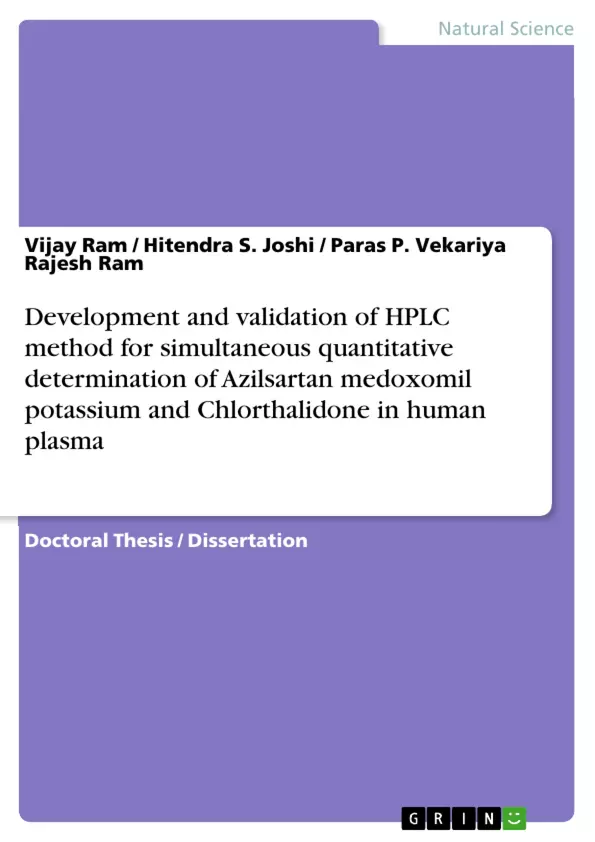The objective of this work was to develop a simple, cost effective, rugged and a high throughput method for simultaneous estimation of Azilsartan and Chlorthalidone in human plasma. Solid phase extraction technique is introduced here for first time and its advantages are: (I) Short processing time, (II) Significant reduction in the labour and (III) This technique minimizes chances of errors, saves considerable time and simplifies the sample preparation methodology. The run time per sample analysis of 15.0 min suggests the high throughput of the proposed method. From the results of all the validation parameters, the method proposed here can be useful for therapeutic drug monitoring both for analysis of routine samples of single dose or multiple dose pharmacokinetics and also for the clinical trial samples.
Inhaltsverzeichnis (Table of Contents)
- Chapter 1: Introduction
- Section-1: General introduction
- Chapter-2: Development and validation of RP-HPLC methods for quantitative determination of some bioactive molecules in human plasma
- Section-1: Development and validation of HPLC method for simultaneous quantitative determination of Azilsartan medoxomil potassium and Chlorthalidone in human plasma by HPLC
Zielsetzung und Themenschwerpunkte (Objectives and Key Themes)
This work aims to develop and validate a reliable and efficient high-performance liquid chromatography (HPLC) method for the simultaneous quantitative determination of Azilsartan medoxomil potassium and Chlorthalidone in human plasma. The study explores the application of HPLC for analyzing bioactive molecules in biological matrices.
- Development and validation of an HPLC method for simultaneous quantification of Azilsartan medoxomil potassium and Chlorthalidone in human plasma.
- Assessment of the method's analytical performance characteristics, including linearity, accuracy, precision, and sensitivity.
- Application of the developed HPLC method for analyzing bioactive molecules in biological matrices.
- Investigation of the potential of HPLC for bioanalytical studies.
- Advancement of analytical methodologies for pharmaceutical analysis.
Zusammenfassung der Kapitel (Chapter Summaries)
Chapter 1 provides a comprehensive overview of bioanalytical techniques, including chromatography types, sample preparation methods, method validation, and bioavailability/bioequivalence concepts. The chapter also introduces the active pharmaceutical ingredients (APIs) Azilsartan medoxomil and Chlorthalidone, outlining their significance and applications.
Chapter 2 focuses on the development and validation of the RP-HPLC method for the simultaneous quantitative determination of Azilsartan medoxomil potassium and Chlorthalidone in human plasma. The chapter outlines the objectives, experimental procedures, method development process, results and discussion, and concluding remarks.
Schlüsselwörter (Keywords)
Key terms and concepts explored in this research include HPLC method development, validation, Azilsartan medoxomil potassium, Chlorthalidone, bioanalytical techniques, quantitative determination, human plasma, and bioactive molecules. The study emphasizes the application of HPLC for pharmaceutical analysis and its role in advancing analytical methodologies.
- Arbeit zitieren
- Dr. Vijay Ram (Autor:in), Hitendra S. Joshi (Autor:in), Paras P. Vekariya Rajesh Ram (Autor:in), 2014, Development and validation of HPLC method for simultaneous quantitative determination of Azilsartan medoxomil potassium and Chlorthalidone in human plasma, München, GRIN Verlag, https://www.grin.com/document/286149



